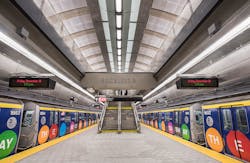FTA issues FONSI for Phase 2 of MTA Second Ave. Subway
The Federal Transit Administration (FTA) allowed a step forward for the second phase of the Metropolitan Transportation Authority’s (MTA) Second Avenue Subway with the issuance of a Finding of No Significant Impact (FONSI) based on review of the Supplemental Environmental Assessment for the project.
“This is an important milestone,” said MTA Chief Development Officer Janno Lieber. “With the environmental approval in place, we can move into a new phase in the effort to secure federal funding for this important project. It’s urgent to build Second Avenue Subway Phase 2 so East Harlem can begin to receive the same benefits Phase 1 has delivered for the Upper East Side.”
The first phase of the project opened Jan. 1, 2017, and was the system’s first major expansion in more than 50 years. Phase 2 of the project will extend the Q Subway train line from its current terminus at 96th Street and Second Avenue, north to 125th Street, then west to Lexington and Park Avenues, where it will connect with the 4, 5 and 6 trains and the Metro-North Railroad. Three new stations will be built at 106th Street and Second Avenue, 116th Street and Second Avenue and 125th Street and Lexington Avenue. Tail tracks, where trains will be stored prior to heading back south, will continue west just past Lenox Avenue.
MTA says Phase 2 of the project will provide a number of benefits for the East Harlem community, much of which sits in a “transit desert” with few public transportation choices. The new service will also stimulate the local economy, create thousands of jobs, cut commute time by up to 20 minutes a day, and further reduce crowding on the Lexington Avenue line. Following opening of the first phase of the line, crowding was reduced at parallel stations on the 4, 5 and 6 trains by up to 40 percent during the morning rush hour.
The FONSI was issued after an extensive update of the original Environmental Impact Statement prepared in 2004. The finding means that changes to the design of the project since that time were found to have no additional significant adverse impact on the environment in the construction area.
About the Author

Mischa Wanek-Libman
Group Editorial Director
Mischa Wanek-Libman is director of communications with Transdev North America. She has more than 20 years of experience working in the transportation industry covering construction projects, engineering challenges, transit and rail operations and best practices.
Wanek-Libman has held top editorial positions at freight rail and public transportation business-to-business publications including as editor-in-chief and editorial director of Mass Transit from 2018-2024. She has been recognized for editorial excellence through her individual work, as well as for collaborative content.
She is an active member of the American Public Transportation Association's Marketing and Communications Committee and served 14 years as a Board Observer on the National Railroad Construction and Maintenance Association (NRC) Board of Directors.
She is a graduate of Drake University in Des Moines, Iowa, where she earned a Bachelor of Arts degree in Journalism and Mass Communication.
